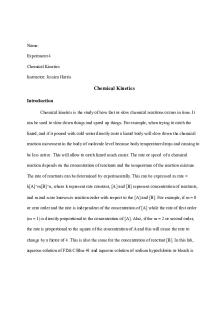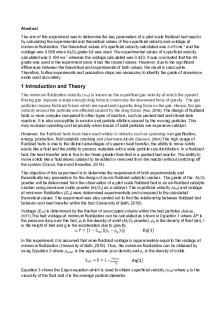Lab Report 1 (Electrolysis) (CHE142) (EH110) (Diploma in Chemical Engineering UiTM) PDF

| Title | Lab Report 1 (Electrolysis) (CHE142) (EH110) (Diploma in Chemical Engineering UiTM) |
|---|---|
| Author | Syafiq Ehsan |
| Course | Diploma in Chemical Engineering |
| Institution | Universiti Teknologi MARA |
| Pages | 7 |
| File Size | 293.5 KB |
| File Type | |
| Total Downloads | 86 |
| Total Views | 142 |
Summary
Lab Report 1 (Electrolysis) (CHE142) (EH110) (Diploma in Chemical Engineering UiTM)
Contains Intro, Objective, Procedure and Safety Precaution, Apparatus and Materials, Results and Data, Discussion, Conclusion and References of the reports.Extra Tips Inside on how to get marks....
Description
CONFIDENTIAL
EH/OCT 2020/CHE142
UNIVERSITI TEKNOLOGI MARA LABORATORY
COURSE
:
INORGANIC AND PHYSICAL CHEMISTRY
COURSE CODE
:
CHE142
ASSESSMENT
:
EXPERIMENT 1/2/3/4
Course Outcomes:
Construct laboratory work to display the concept of chemical reactions in chemistry
Item
Introduction & objective Materials, procedure & safety precaution Data, results & discussion Organization & appearance Question & answer (Post-experiment) Peer evaluation GRAND TOTAL (CO4,LO3)
Marks
/100
FA UiT 943 Sar Tel
CHEMICAL ENGINEERING an Sarawak, Kampus Samarahan marahan ysia. 200
TECHNICAL/EXECUTIVE REPORT : CHEMICAL ENGINEERING Title of Exp No. :
1
Experimen
Faraday constant and Avogadro constant through electrolysis
t: Topic :
Electrochemistry
Mark :
10
Date : Students
Course : No .
Semester : Name
1
Muhammad Nazrul Syahmi Bin Nizam
2
Muhammad Faiq Hakimi bin Ruzlan
3
Syafiq Ehsan Bin Mohd Suhkeri
4
Mohammad Zulkhairi Bin Zamli
Group : Matrix No.
2 Signatu re
202061703 2 202046922 4 202088247 2 202082446 2
5 Lecturer
1. Geraldine Chan Sue Ching 2.
Introduction : Electrolysis is a process of producing a chemical change in an electrolytic cell. The electrolytic cell is an electrochemical cell in which an external energy sources drives nonspontaneous reaction. In the aqueous, ions with positive and negative charges exist. Therefore, it will allow electric current to flow through by the work of electrons moving from anode to cathode producing electricity. In order to separate the product, electrolysis applied. The amount of reaction occurred at the electrodes is equivalent to the number of electrons transferred. Faraday defined as the sum of charge carried by Avogadro’s number of electrons, or 1 mole of electrons.
This report discuses an experiment to study on how to determine the values of Faraday and Avogadro’s Number through electrolysis. It is performed by applying electrolysis process where the values of the Faraday number F is measured by the amount of charge required to reduce 1
mole H+ ions as stated in the reaction: 2H+ + 2e-
H2
Coulomb (C) which is the amount of electrical charge that reach a point in a circuit when current (I) of 1 Ampere flows for a second used to measure electric charge (q). The elementary charge on a single electron founded by Robert Milikan is equal to 1.6 x 10-19 C. Throughout the experiment, the time, volume and ammeter reading recorded and the data is collected to be written in a table. To conclude this experiment, the values of Faraday and Avogadro number can be determined by electrolysis.
Objective : To determine the values for the Faraday and Avogadro’s Number by electrolysis.
Materials Materials and Apparatus , Procedur e&
DC source of electricity, insulated copper wires(2), 250-mL beaker, ring stand, ammeter, timer of watch, 50-mL buret, clamp, thermometer, barometer, glass stirring rod and millimeter ruler or meter stick.
Safety Precauti
Procedures
ons 1. DC source and an ammeter is obtained. The apparatus was arranged according to the given diagram, the polarity of the ammeter was observed and taken care of. The ammeter was set to it’s 5A scale and the DC source to 5 Volts. 100mL of distilled water and 50mL of dilute (3M) sulfuric acid was poured into the 250mL
beaker. The mixture was carefully stirred using a glass rod. 2. The solution was poured into an inverted 50mL buret and held in place by a ring stand with a clamp.
3. The copper wire cathode was attached to the negative terminal of the DC source and the other uninsulated end into the mouth of the inverted buret. All of the bare wire was made sure to be wholly inside the buret to make sure no H2 gas is lost. 4. The anode electrode was hung over the edge of the beaker while immersed in the acid solution meanwhile the other end was attached to the positive electrode of the DC source. 5. The time was recorded. The DC source was turned on to record the reading displayed on the ammeter. The electrolysis was carefully conducted so the electrodes will not move around. 6. The electrolysis was continued until at least 20mL of hydrogen had been collected. The time was noted. Safety Precautions 1. Position eyes parallel to the ammeter’s needle to avoid any reading error. 2. Equip enough PPE when conducting the experiment to avoid injuries 3. Lab fire extinguisher must be present at all times in case of fire or explosive incidents. 4. Handle said chemicals with caution to avoid spills
Data, Results & Discussio n
Report
Results
Time of reaction started
2.25 p.m
Time of reaction terminate
2.52 p.m
Volume of hydrogen
20.00 ml
Temperature of solution
28˚C
Height of water column
350 mm
Initial volume in buret
38.00 ml
Final volume in buret
18.00 ml
Current
0.2A
Data
Discussions There are some major sources of error can be seen. One of it is that eye is not perpendicular to the scale of buret and beaker. This type of error known as parallax error. It can cause a wrong reading of the measurement of the solution so the result may be incorrect and can lead to increasing of percentage error. Besides that, when adding the solution, it bust be done on a flat surface area in order to get a more accurate reading. This kind of mistake can cause it to not hold water in a fixed position, consequently the reading would have a huge difference in comparison to the actual one.
PH 2=760 mmHg – 28.3 mmHg – 25.725 ¿ 705.975 mmHg
n=
P H 2V RT
Q=It
Q=( 0.2 )( 27 × 60 ) Q=324 C e=
( 705.975 )( 0.02 ) (62.4 )(301)
2 e=7.518 × 10−4 ( 2 ) =
1.5036 ×10
−3
−¿=
It F
n e¿ −¿ ne It F= ¿ 324 F= 1.5036 ×10−3 F=215482.8412 −5 F=2.1548× 10 2.1548× 10−5−96485 ×100 96485 ¿ 122.87 %
δF=
N A=
2.1548 ×10−5 −19 1.6 ×10
¿ 1.347 ×10
δ NA =
24
1.347 ×1024 −6.022 × 1023 ×100 6.022 × 1023
¿ 123.68 % The rate of H2 produced can be increased by increasing the concentration of H2SO4 solution. As a result, time taken to obtain 200mL of H 2 gas will be reduced. Because more effective collision occurs at the cathode electrode. Hence, the rate of H + ions discharged will increase as well. Platinum can substitute copper wire as an electrode to get a more accurate result. Compared to the copper wire, it will not be involved in this reaction due to it’s inert properties. So, platinum will not become thinner or corrode.
Conclusi on:
In conclusion, this electrolysis experiment was aimed to find the value of Faraday Constant and Avogadro’s Number which have been used by scientist worldwide, NA = 6.022 x 1023 for Avogadro’s Number and F = 96485.33 C mol-1 for Faraday Constant. Through electrolysis, moles of electron transferred can be calculated from the amount of hydrogen produced which are then used to count the value for Faraday’s Constant as well as Avogadro’s Number. However, noted that the new values are not exactly the same as the original due to some errors encountered during experimenting. Overall, this experiment was a success and at the end, the goals of determining both constant values were achieved.
Referenc e:
Darrell D. Ebbing Steven D. Gammon, General Chemistry, Eleventh Edition. Detroit, Michigan: Cengage Learning. http://www.chemispheretoday.com/resources/152-Lab-Manual2014/12_electrolysis.pdf...
Similar Free PDFs

Chemical Kinetic Lab Report
- 2 Pages

Lab Report Chemical Composition
- 3 Pages

Chemical Kinetics - lab report
- 4 Pages

ENGINEERING MATERIALS LAB REPORT
- 1 Pages

Mechanical engineering lab report
- 18 Pages

UiTM Traffic Noise Study Lab Report
- 12 Pages

UiTM Spot Speed Study Lab Report
- 18 Pages

LAB Report Traffic Volume Study uitm
- 25 Pages

Lab 11 Chemical Kinetics Report
- 4 Pages
Popular Institutions
- Tinajero National High School - Annex
- Politeknik Caltex Riau
- Yokohama City University
- SGT University
- University of Al-Qadisiyah
- Divine Word College of Vigan
- Techniek College Rotterdam
- Universidade de Santiago
- Universiti Teknologi MARA Cawangan Johor Kampus Pasir Gudang
- Poltekkes Kemenkes Yogyakarta
- Baguio City National High School
- Colegio san marcos
- preparatoria uno
- Centro de Bachillerato Tecnológico Industrial y de Servicios No. 107
- Dalian Maritime University
- Quang Trung Secondary School
- Colegio Tecnológico en Informática
- Corporación Regional de Educación Superior
- Grupo CEDVA
- Dar Al Uloom University
- Centro de Estudios Preuniversitarios de la Universidad Nacional de Ingeniería
- 上智大学
- Aakash International School, Nuna Majara
- San Felipe Neri Catholic School
- Kang Chiao International School - New Taipei City
- Misamis Occidental National High School
- Institución Educativa Escuela Normal Juan Ladrilleros
- Kolehiyo ng Pantukan
- Batanes State College
- Instituto Continental
- Sekolah Menengah Kejuruan Kesehatan Kaltara (Tarakan)
- Colegio de La Inmaculada Concepcion - Cebu






